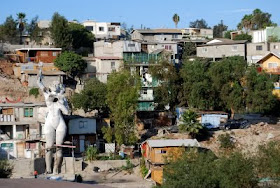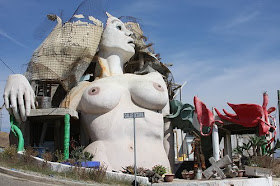Building-sculpture of "La Mona" in Tijuana. by “Derrick”. From his blog http://derrikchinn.blogspot.com/
As we can see in the following definitions, architecture is completely related to Arts. In the history of modern Art, the collage is an approach to architecture. Collage was invented by the Cubists as a means of exploring the differences between representation and reality. It gave the canvas a 3D dimension.
The first sign of this approach was the experimentation with materials and textures in Post-painterly abstraction; the pure painting seemed to be exhausted, and artists who wished to find their way forward were inclined to abandon temporarily the idea of painted canvas as a vehicle for what they wanted to do or say. This resulted in a new attention to sculpture and an increasing number of experiments with mixed media (E. Lucie-Smith, p. 112), where architecture and art shared a blurry frontier.
Artist Joseph Cornell's box: the 3 dimensions of Art. Web download.
There are some different definitions for the term “Architecture”:
The art and science of designing and erecting buildings based on a functional program and employing the technology available at that time. (Arts and construction)
A style and method of design and construction. (Style and methodology)
Orderly arrangement of parts; structure (Composition and techtonics).
The result of all the constituent elements originated in the relationship between the space that a building produces and its surrounding space. (Architecture conforming and transforming space).
Traditionally, architecture has been considered one of the six Beautiful Arts; in the best of its manifestations, Architecture conjoins beauty and utility, to a degree that both interactive characteristics become essential. It is said that it is only Art when the construction is the expression of a society’s spiritual will in a certain period of history.
The Roman architect Marco Vitruvio (SI BC), in his treaty L’Architettura, says that architecture rests in three principles: the beauty (Venustas) the building possesses; the firmness (Firmitas), or supporting structure; the utility (Utilitas) or function to which the building is destined. In SXV, the architect and artist Leon Battista Alberti sustained that architecture was a construction where the movement of the weights and the union of the bodies, was adapted, of the most beautiful form, to the own needs of the human beings. In SXIX, the architect and theorist Eugene Viollet-le-Duc considered that Architecture or the art of build, had two parts equally important: theory and practice; the art critic and social thinker John Ruskin (1849), who was concerned about socio-cultural and economical issues, defined the architecture as the art of decorate and compose buildings of any destiny which contemplation should contribute to health, strength and pleasure of the human spirit. In modern times, the historian Sigfried Giedion stipulated that the architectural creation was the correct application of materials and of the economic principles to the creation of spaces for the man.
Resuming, in theory, while a building complies with conditions of firmness, function and beauty, it will be considered a work of architecture. And Art, by definition, is the quality, production, expression, or realm, according to aesthetic principles, of what is beautiful, appealing, or of more than ordinary significance. If Art means to satisfy human spirits, then, it has no need for “Utilitas”, though it needs Venustas and Firmitas.
In the last fifty years, beginning with pop art, these considerations are not like black and white. In some cases, Art has been eclipsed by non-art and architecture eclipsed by non-architecture. Here, there is no way to find a frontier between both disciplines, both of them are joined in one discipline, maybe I can call it “artchitecture”.
In “artchitecture”, I find four different resolutions –for now-:
1) The bizarre buildings, closer to vernacular architecture, where everything is possible, any shape or alien image that was never related to architecture.
Ladder to access inside "La Mona". The building-sculpture has an access at the back and a window at the breasts location. It is possible to see the neighborhood around once inside the "statue". Picture by “Derrick”. From his blog http://derrikchinn.blogspot.com/
A bizarre house in Baja California, Mexico.http://www.flickr.com/photos/xdisone/3094148962/
2) The buildings as a clear manifestation of a recognizable artistic style. In this category, I would add the appropriate technology constructions that also belong to landscape and natural art.
Coca Cola building in Las Vegas. Once you approach it, it is possible to see the standard interior floor plans. The sculpture consists of a glass liner, with the shape of a Coke bottle. It is a reminder of pop art with a clean technology. From commons.wikimedia.org/wiki/File:Coca_Cola_bui...
3) Buildings where one or two of the three Vitruvian standard principles are missing, in consequence, the building could be considered a work of art, though it also contains the function….
House in Poland challenging "Firmitas". Created by Polish businessman and philanthropist, Daniel Czapiewski.The house represents the Communist era and the state of the world.http://quazen.com/arts/architecture/crazy-and-bizarre-architecture/
Cantilevered house. This one defies gravity. Cantilever houses use a beam supporting on only one end. The beam carries the entire load of the building without any other external help. Though "Firmitas" is correct, our perception of lack of gravity makes it appear as an object of art. http://quazen.com/arts/architecture/crazy-and-bizarre-architecture/
4) Buildings where the materiality is not conventional and is closer to the collages or installations ideas. The structure (Firmitas) cannot be seen as typical as it is a consequence of utilizing innovative materials due to lack of the standard ones. It is close to vernacular architecture.
Glass bottle house. From Weburbanist.com
More definitions of architecture will be written in SXXI, as there are new dimensions involved. As the scientific dimension, the one that Vitruvio never dreamt of. Genetic manipulation applied to construction materials, virtual spaces, robots building perfect digital designs in the middle of the New York streets, designs that do not contain the imperfections of human labor. So impeccable they are, that any artistic form is developed, for any function and material: "We marry the digital reality of the computer with the material reality of a building," (Science Daily.com, 2009) say the two architects in charge of my NY’s example, Fabio Gramazio and Matthias Kohler, who both teach and research at ETH Zurich. They call this approach "digital materiality", term that is not found in any of the historical treaties.
REFERENCES
http://www.almendron.com/arte/arquitectura/claves_arquitectura/ca_01/ca_011/arquitectura_011.htm
http://www.myetymology.com/encyclopedia/Architecture.html
Robot Builds Brick Wall In New York City. In Science News. October 26, 2009
http://www.sciencedaily.com/releases/2009/10/091026133016.htm
Lucie-Smith Edward. Movements in art since 1945. Singapore, 1995.








No comments:
Post a Comment